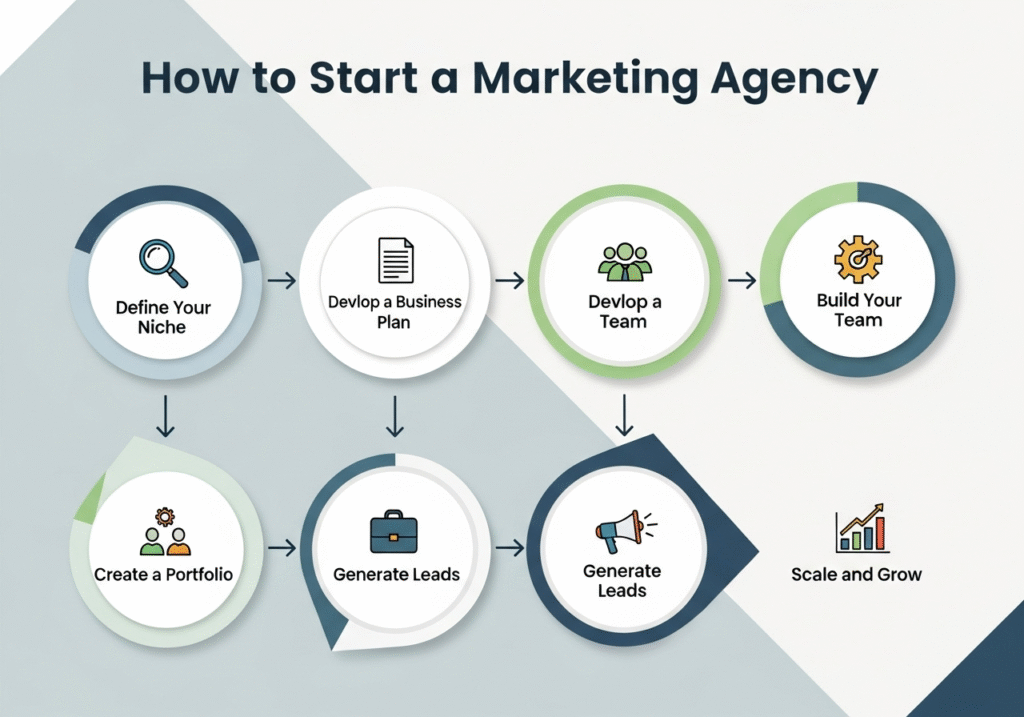Link baiting is one of the smartest ways to earn high-quality backlinks without begging other websites to link to you. When done right, how to do link baiting in SEO becomes your secret weapon for building domain authority and climbing search rankings naturally.
This guide is perfect for content marketers, SEO specialists, and business owners who want to create content that people actually want to share and link to. Instead of chasing links, you’ll learn how to make them come to you.
We’ll start by breaking down the core link baiting strategies that turn ordinary content into link magnets. You’ll discover which content formats consistently attract the most backlinks, from interactive tools to data-driven studies.
Finally, we’ll cover the promotion tactics that get your content in front of the right people who have the power to link back to you. Ready to transform your content from ignored to irresistible? Let’s dive into the proven techniques that make websites naturally want to reference your work.
What Is Link Baiting Fundamentals For SEO Success?

Define Link Baiting and Its Role in Modern SEO Strategy
Link baiting represents a strategic approach to creating content so compelling that other websites naturally want to link to it. Think of it as digital magnetism – your content becomes so valuable, entertaining, or informative that other site owners can’t resist sharing it with their audiences.
In today’s SEO landscape, link baiting strategies have become essential because search engines like Google prioritize websites that earn genuine, high-quality backlinks. Rather than chasing after links through outdated tactics, smart marketers focus on SEO link building through content that genuinely deserves attention.
The beauty of effective link baiting lies in its organic nature. When you create content that solves real problems, entertains audiences, or provides unique insights, other content creators naturally reference and link to your work.
This organic linking pattern signals to search engines that your content has genuine value, which can significantly improve domain authority over time.
Modern content marketing for SEO relies heavily on this principle. Instead of trying to manipulate rankings through artificial means, successful SEO professionals understand that creating link-worthy content forms the foundation of sustainable search visibility.
Identify The Psychological Triggers That Make Content Shareable
Understanding human psychology is crucial for mastering how to do link baiting in SEO effectively. Several key triggers motivate people to share and link to content across the web.
Emotion drives action. Content that evokes strong feelings – whether surprise, joy, anger, or inspiration – gets shared more frequently. People naturally want to share experiences that moved them emotionally with their networks.
Utility creates value. Practical content that helps people solve problems or achieve goals attracts links because it serves as a useful resource. Think comprehensive guides, tools, calculators, or step-by-step tutorials that people bookmark and reference repeatedly.
Novelty captures attention. Fresh perspectives, breaking news, or unique research findings naturally attract links because they offer something new to conversations. Being first to cover emerging trends or providing exclusive insights gives others reasons to cite your work.
Social proof influences behavior. Content backed by credible sources, featuring expert opinions, or showcasing impressive statistics gains credibility that encourages linking. People feel more confident sharing content that appears authoritative and well-researched.
Ego and identity matter. Content that makes people look smart, informed, or aligned with their values gets shared because it reflects positively on the sharer. Creating content that enhances someone’s professional reputation or personal brand motivates natural linking behavior.
Distinguish Between Ethical Link Baiting and Manipulative Tactics
Understanding the difference between legitimate link bait techniques and manipulative practices protects your website from potential penalties while building sustainable SEO success.
Ethical link baiting focuses on creating genuinely valuable content that deserves attention. This approach includes:
- Publishing original research and data
- Creating comprehensive educational resources
- Developing useful tools and calculators
- Sharing expert insights and commentary
- Producing entertaining content with substance
Manipulative tactics try to game the system without providing real value:
| Ethical Approach | Manipulative Tactic |
|---|---|
| Original research findings | Fabricated statistics |
| Genuine expert interviews | Fake testimonials |
| Useful free tools | Bait-and-switch content |
| Well-researched articles | Clickbait with no substance |
| Honest product reviews | Paid promotional disguised as editorial |
The key difference lies in intent and execution. Ethical strategies aim to attract backlinks SEO by creating content that genuinely helps, informs, or entertains audiences. Manipulative approaches prioritize short-term link gains over long-term reputation and user satisfaction.
Search engines have become increasingly sophisticated at identifying and penalizing manipulative link building attempts. Websites that focus on ethical practices build stronger, more sustainable SEO performance while maintaining their reputation and credibility.
Recognize the Connection Between Quality Content and Natural Backlinks
High-quality content and natural backlinks share an inseparable relationship that forms the backbone of successful SEO backlink tips. When you consistently produce valuable content, links follow naturally without forced promotion or artificial manipulation.
Quality creates demand. Well-researched, thoroughly written content becomes a reference point for others in your industry. Journalists, bloggers, and content creators regularly search for authoritative sources to support their own work, making comprehensive, accurate content highly link-worthy.
Depth builds authority. Detailed, comprehensive content that thoroughly covers topics attracts more links than surface-level articles. When your content becomes the definitive resource on a subject, others naturally reference it in their own work.
Consistency establishes reputation. Regularly publishing high-quality content builds trust with both audiences and search engines. As your reputation for valuable content grows, others become more likely to link to your new publications based on your track record.
User experience influences sharing. Content that’s easy to read, well-formatted, and provides clear value gets shared more frequently. People link to resources that enhance their readers’ experience rather than content that feels self-promotional or difficult to consume.
The most effective way to increase backlinks naturally involves focusing relentlessly on user value. When your content consistently solves problems, answers questions, or provides entertainment value, links accumulate organically as a natural byproduct of quality. This approach creates sustainable SEO growth that withstands algorithm changes and builds lasting online authority.
Proven Link Baiting Strategies That Generate Quality Backlinks

Create Comprehensive Resource Guides And Ultimate Tutorials
Resource guides and ultimate tutorials consistently earn high-quality backlinks because they solve complex problems in one comprehensive location. When you create the definitive guide on a specific topic, other websites naturally reference and link to your content as the authoritative source.
Start by identifying knowledge gaps in your industry where scattered information exists across multiple sources. Your goal is to consolidate this information into one exhaustive resource that becomes the go-to reference.
These link baiting strategies work exceptionally well because they provide genuine value while positioning your site as an industry authority. Successful resource guides typically include step-by-step instructions, downloadable templates, checklists, and real-world examples.
For instance, if you’re in digital marketing, create “The Complete Guide to Email Marketing Automation” with workflow templates, subject line formulas, and case studies from successful campaigns. Structure your guides with clear navigation, detailed table of contents, and visual elements that break up text.
This approach not only improves user experience but also makes your content more linkable. Other bloggers and content creators will reference specific sections of your guide when they need to support their own arguments or provide additional resources to their readers.
Develop Original Research And Industry Surveys
Original research stands out as one of the most effective SEO link building techniques because it provides unique data that doesn’t exist anywhere else. When you publish industry surveys, studies, or data analyses, you create exclusive content that journalists, bloggers, and industry experts must link to when citing your findings.
Conduct surveys within your industry to uncover trends, challenges, or consumer behaviors. Even small-scale research with 100-200 participants can yield valuable insights that attract significant attention. Partner with industry associations or leverage social media to distribute your surveys and gather responses.
Present your research findings through multiple formats: detailed reports, executive summaries, and visual representations. Include methodology, sample sizes, and raw data when appropriate to establish credibility. This transparency encourages more citations and links from academic and professional sources.
Time your research releases strategically around industry events, conferences, or relevant news cycles. Media outlets and industry publications actively seek fresh data to support their stories, making your research more likely to earn coverage and backlinks.
Design Compelling Infographics And Visual Content
Visual content naturally attracts links because people love sharing and embedding graphics that tell compelling stories. Infographics transform complex data or processes into digestible, shareable formats that other content creators want to include in their own articles and presentations.
Focus on creating infographics that address trending topics or evergreen industry challenges. Use your original research data, compile industry statistics, or visualize step-by-step processes that your audience finds valuable. The key is ensuring your viral content SEO approach balances visual appeal with substantive information.
Design infographics with your branding clearly visible but not overwhelming. Include your website URL and a brief description that makes embedding easy for other sites. Provide embed codes and multiple size options to remove friction for potential linkers.
Expand beyond traditional infographics to include interactive charts, comparison graphics, timeline visualizations, and animated graphics. These formats often perform better on social media and are more likely to be referenced by other websites looking to enhance their own content.
Craft Controversial Yet Valuable Opinion Pieces
Well-researched opinion pieces that challenge conventional wisdom or address contentious industry topics can generate significant discussion and links. The key is backing controversial positions with solid evidence and presenting arguments that add genuine value to industry conversations.
Choose topics where you have legitimate expertise and can offer unique perspectives backed by experience or data. Avoid controversy for its own sake, but don’t shy away from addressing uncomfortable truths or challenging widely accepted practices in your industry.
Structure controversial content carefully by acknowledging counterarguments and presenting balanced perspectives while maintaining your position. This approach demonstrates thought leadership rather than simple contrarianism, making your content more credible and link-worthy.
Monitor industry discussions, social media conversations, and competitor content to identify topics generating debate. Your controversial opinion pieces should contribute meaningfully to these conversations rather than simply stirring up conflict for attention.
Content Formats That Naturally Attract Links

Build Interactive Tools And Calculators For Your Niche
Interactive tools and calculators create massive link-building opportunities because they provide immediate value to users while solving specific problems in your industry. These link bait techniques work exceptionally well because other websites naturally want to reference useful resources their audience can actually use.
Start by identifying common calculations or processes your target audience performs regularly. A mortgage calculator for real estate sites, ROI calculators for marketing blogs, or calorie counters for fitness websites all serve as perfect examples.
The key lies in making your tool genuinely helpful rather than just a basic calculator anyone could create. Design your interactive tools with sharing in mind. Include embed codes so other websites can easily feature your calculator on their pages while linking back to your site.
Add social sharing buttons and make sure the tool works flawlessly across all devices. When people find your tool useful, they’ll bookmark it, share it, and naturally link to it in their own content.
The best interactive tools often become industry standards that competitors and complementary businesses reference repeatedly. This creates a steady stream of natural backlinks over time, making your initial investment in development pay dividends for years.
Produce In-Depth Case Studies with Actionable Insights
Case studies represent some of the most linkable content because they provide real-world proof and actionable data that other content creators desperately want to reference.
When you document actual results, methodologies, and lessons learned, you create content that naturally becomes a go-to resource for industry discussions. Focus on creating comprehensive case studies that reveal the complete process, not just surface-level results.
Include specific metrics, timelines, challenges faced, and exact strategies used. Screenshots, graphs, and detailed explanations make your case study more credible and shareable. Other websites will link to your case study when they want to support their own arguments with concrete evidence.
Choose case studies that address common industry challenges or showcase innovative approaches. Document everything from the initial hypothesis through final results, including any unexpected findings or failures. This transparency makes your content more valuable and trustworthy.
Make your case studies evergreen by focusing on principles and methodologies rather than just specific tools or platforms that might become outdated. Include downloadable resources like templates, checklists, or frameworks that readers can apply to their own situations.
Curate Expert Roundups and Interview Collections
Expert roundups and interview collections work as powerful SEO link building assets because they naturally encourage participation and sharing from industry influencers. When you feature experts in your content, they typically share and link back to the piece, amplifying your reach significantly.
Create focused roundups around trending topics or persistent industry challenges. Reach out to 10-15 recognized experts and ask them specific, thoughtful questions that generate actionable insights.
Avoid generic questions that produce cookie-cutter responses. Instead, craft questions that encourage experts to share unique perspectives or personal experiences. Structure your roundups for maximum readability and shareability.
Include professional headshots, brief expert bios, and highlight key quotes or takeaways. Create social media graphics featuring individual expert quotes to encourage sharing across platforms. Follow up with participants by sending them the published piece and any relevant graphics.
Most experts will share content featuring their contributions, which naturally generates backlinks and social signals. Consider creating annual or quarterly expert roundups on the same topic to build anticipation and establish your site as a go-to resource for industry insights.
The most successful expert roundups often get referenced in other articles, included in newsletter recommendations, and bookmarked as valuable resources, creating ongoing link-building benefits long after publication.
Optimizing Your Content For Maximum Link Attraction

Write Magnetic Headlines That Encourage Sharing
Your headline determines whether people click on your content or scroll past it. Creating compelling headlines for link baiting strategies requires balancing curiosity with clear value.
Use numbers to make your headlines specific: “17 Marketing Mistakes That Are Killing Your Conversions” performs better than “Common Marketing Mistakes.” Questions also work well, especially when they address pain points your audience faces regularly.
Power words like “ultimate,” “proven,” “secret,” and “insider” grab attention, but use them sparingly. Your headline should promise something valuable while creating urgency. “The Complete Guide to SEO Link Building That Google Actually Rewards” tells readers exactly what they’ll get and positions your content as comprehensive and trustworthy.
Test different headline variations using tools like CoSchedule’s Headline Analyzer. Headlines with 6-8 words tend to get the most clicks, while emotional headlines drive more social shares. Remember that your headline needs to work across platforms – what looks great on your blog might get cut off in social media feeds.
Structure Content For Easy Scanning And Consumption
People don’t read online content word-for-word. They scan for information that’s relevant to them. Break your content into digestible chunks using short paragraphs, bullet points, and numbered lists. Each paragraph should contain one main idea, making it easy for readers to jump between sections.
Use descriptive subheadings that tell readers what they’ll learn in each section. Instead of generic headings like “Tips” or “Methods,” try specific ones like “Three Ways to Double Your Backlink Success Rate.” This approach helps readers find exactly what they need while improving your content’s SEO performance.
Create visual breaks with images, charts, and infographics. These elements make your content more shareable and give readers’ eyes a rest. When people can quickly scan your content and understand its value, they’re more likely to link to it as a resource.
White space is your friend. Dense blocks of text overwhelm readers and increase bounce rates. Add space between sections, use shorter sentences, and consider formatting important points in boxes or callouts to make them stand out.
Include Compelling Statistics And Data Points
Data-driven content naturally attracts backlinks because other writers need credible sources to support their arguments. Research industry reports, conduct original surveys, or analyze existing data to uncover interesting insights.
When you present unique statistics or fresh perspectives on common data, you create valuable link bait techniques that others want to reference. Always cite your sources and make your data easy to understand.
Create simple charts or graphs that visualize complex information. A well-designed infographic with surprising statistics can attract backlinks SEO and social shares simultaneously.
Look for counterintuitive findings that challenge conventional wisdom. Why 73% of Small Businesses Fail at Content Marketing (And How to Join the 27% That Succeed)” uses a specific statistic to create intrigue while promising a solution.
Update your statistics regularly to keep content fresh and maintain its value as a reference source. Outdated data weakens your content’s authority and reduces its linking potential over time.
Add Shareable Quotes And Key Takeaways
Memorable quotes and actionable takeaways make your content sticky and shareable. Create quotable moments by distilling complex concepts into simple, powerful statements. “Content without promotion is like winking in the dark” is more memorable than a paragraph explaining why content promotion matters.
Design quote cards for social media that highlight your best insights. These visual elements increase shares and drive traffic back to your full content. Use tools like Canva to create professional-looking quote graphics that maintain your brand consistency.
Include a “Key Takeaways” section at the end of major points or sections. Busy readers appreciate having main points summarized clearly. These takeaways often get quoted in other articles, creating natural backlink opportunities.
Make your quotes actionable rather than just inspirational. “Publish content consistently for 90 days before judging its effectiveness” gives readers a specific action step they can implement immediately.
Implement Strategic Internal Linking Throughout Content
Internal linking keeps readers engaged while distributing link equity throughout your site to improve domain authority. Link to related content that provides additional value or context. When discussing content marketing for SEO, link to your posts about specific tactics, case studies, or tools.
Use descriptive anchor text that tells readers what they’ll find when they click. Instead of “click here” or “read more,” use phrases like “discover proven email marketing strategies” or “learn advanced keyword research techniques.” This approach helps both users and search engines understand your content relationships.
Create topic clusters by linking related content together. If you have multiple posts about link building, connect them strategically to create a comprehensive resource hub. This internal linking strategy signals to search engines that you’re an authority on the topic.
Don’t overdo it – 2-5 internal links per 1,000 words keeps your content helpful without becoming spammy. Each link should genuinely add value for readers rather than just boosting your SEO metrics.
Promotion Tactics to Amplify Your Link Baiting Efforts

Target Relevant Influencers And Industry Leaders
Building relationships with key players in your industry can dramatically amplify your link baiting efforts. Start by identifying influencers who regularly share content similar to yours and have audiences that would genuinely benefit from what you’ve created.
Use tools like BuzzSumo or Ahrefs to find these influential voices, then engage with them authentically. The secret lies in providing value before asking for anything. Comment thoughtfully on their posts, share their content with your network, and mention them positively in your own content.
When you do reach out with your link bait piece, they’ll already know who you are. Your outreach message should highlight how your content specifically benefits their audience, not just ask for a share. Industry leaders often appreciate being among the first to discover valuable resources.
Consider giving them early access to your content or asking for their expert opinion during the creation process. This approach transforms them from targets into collaborators, making them more likely to promote your content naturally.
Leverage Social Media Platforms For Content Distribution
Each social media platform requires a tailored approach to maximize your link baiting potential. On LinkedIn, focus on professional insights and industry trends, sharing your content with detailed context about its value to business professionals.
Twitter works best for bite-sized insights and real-time discussions, where you can break down your content into engaging threads. Reddit demands genuine community participation.
Find subreddits relevant to your content topic and become a regular contributor before sharing your own material. The platform’s users have a keen sense for detecting self-promotion, so your contributions need to provide real value to the community.
Facebook and Instagram work well for visual content and behind-the-scenes glimpses of your content creation process. Use Instagram Stories and Facebook Live to give followers a preview of your upcoming link bait content, building anticipation before the official launch.
Engage with Online Communities And Forums
Online communities represent goldmines for organic link building opportunities. Platforms like Quora, industry-specific forums, and niche Facebook groups allow you to answer questions naturally while referencing your content when it genuinely helps solve someone’s problem.
The key to success in these spaces is becoming a helpful community member first. Spend time answering questions without promoting anything, building your reputation as someone who provides value.
When you do share your content, frame it as a resource that addresses specific pain points discussed in the community. Stack Overflow works well for technical content, while niche forums in your industry often have highly engaged audiences looking for expert insights.
Discord servers and Slack communities have become increasingly important, offering real-time opportunities to share valuable resources with engaged professionals.
Use Email Outreach To Potential Linkers
Strategic email outreach remains one of the most effective ways to promote link bait content. Start by identifying websites that have previously linked to similar content or have mentioned topics related to your piece.
Tools like Ahrefs or SEMrush can help you find these opportunities by showing who links to your competitors’ content. Craft personalized emails that demonstrate you’ve actually visited and understood their website.
Reference specific articles they’ve written or causes they support. Your subject line should be specific and benefit-focused, avoiding generic phrases that trigger spam filters. The email body should quickly establish why your content matters to their specific audience.
Include a brief description of your content’s unique value, any impressive metrics or endorsements it’s already received, and a clear but non-pushy call to action. Always make it easy for them to say no while keeping the door open for future opportunities.
Follow up once after a week if you don’t receive a response, but avoid being pushy. Many successful link building relationships start with a “no” but develop over time as you continue providing value to the industry.
Measuring And Analyzing Link Baiting Campaign Performance

Track Backlink Acquisition And Quality Metrics
Tracking your backlink acquisition is crucial for understanding how your link baiting strategies perform. Start by monitoring the total number of new backlinks your content generates within specific timeframes. Tools like Ahrefs, Semrush, or Moz can help you track these metrics effectively.
Focus on quality over quantity when analyzing backlink data. Check the domain authority (DA) and page authority (PA) of linking sites to ensure you’re attracting high-value backlinks. A single backlink from a high-authority website often carries more SEO weight than dozens of low-quality links.
Pay attention to the diversity of your backlink profile. Monitor the types of websites linking to you – news sites, blogs, industry publications, or educational institutions. This variety signals to search engines that your content genuinely provides value across different audiences.
| Metric | Tools | Frequency |
|---|---|---|
| New Backlinks | Ahrefs, Semrush | Weekly |
| Domain Authority | Moz, Ahrefs | Monthly |
| Anchor Text Distribution | All tools | Monthly |
| Link Context | Manual review | As needed |
Monitor Social Shares And Engagement Rates
Social signals often precede backlink acquisition in successful link baiting campaigns. Track shares across major platforms like Facebook, Twitter, LinkedIn, and Pinterest to gauge initial content reception. High social engagement frequently translates into editorial mentions and natural backlinks later.
Monitor engagement depth beyond simple share counts. Look at comments, replies, and discussion quality around your shared content. Meaningful conversations indicate that your content resonates with audiences and increases the likelihood of attracting editorial attention from publishers and bloggers.
Use native platform analytics combined with tools like BuzzSumo to track viral potential. Content that gains traction quickly on social platforms often experiences a snowball effect, leading to increased visibility and more opportunities for organic link building.
Analyze Traffic Increases From Acquired Links
Measure the referral traffic flowing from your newly acquired backlinks using Google Analytics. Set up UTM parameters when possible to track specific campaigns and identify which link bait techniques drive the most valuable traffic.
Examine the quality of referral traffic by analyzing user behavior metrics like bounce rate, time on page, and pages per session. High-quality backlinks typically send engaged visitors who explore your site further, potentially leading to conversions or additional shares.
Create custom segments in Google Analytics to isolate traffic from your link baiting campaigns. This allows you to compare performance against other traffic sources and calculate the true ROI of your SEO link building efforts. Track conversion rates and goal completions from referral traffic to understand the business impact beyond just SEO metrics.

Link baiting isn’t just another SEO tactic – it’s about creating content so valuable that other websites can’t help but link to it. From developing compelling infographics and original research to crafting viral-worthy content and optimizing for maximum shareability, the strategies we’ve covered give you a roadmap to earn high-quality backlinks naturally.
Remember that successful link baiting combines great content creation with smart promotion across social media, email outreach, and industry communities. The real magic happens when you consistently track your results and refine your approach based on what works.
Start with one or two content formats that match your strengths, focus on solving real problems for your audience, and don’t forget to actively promote your content once it’s live. With patience and the right strategy, you’ll watch your backlink profile grow organically while building genuine authority in your industry.



